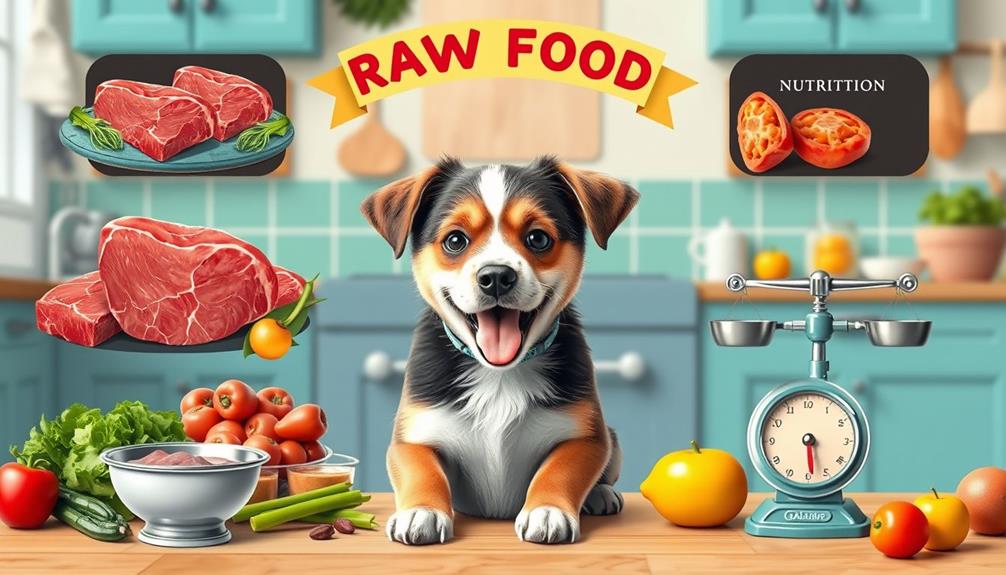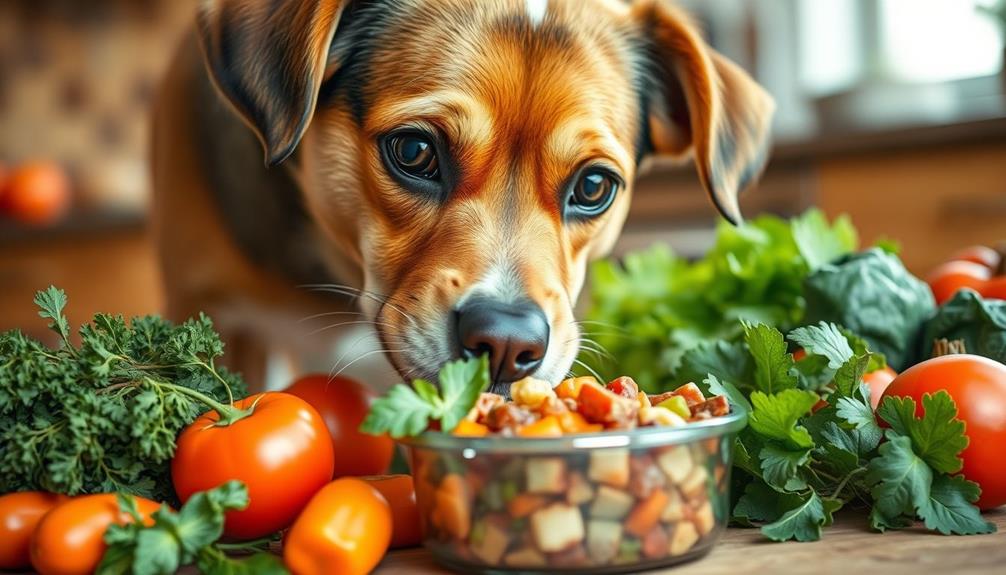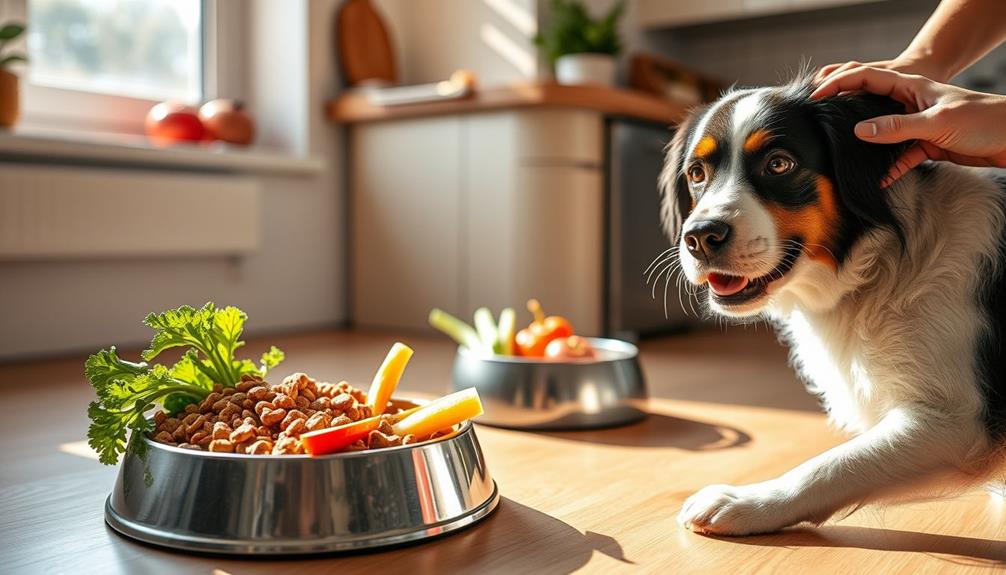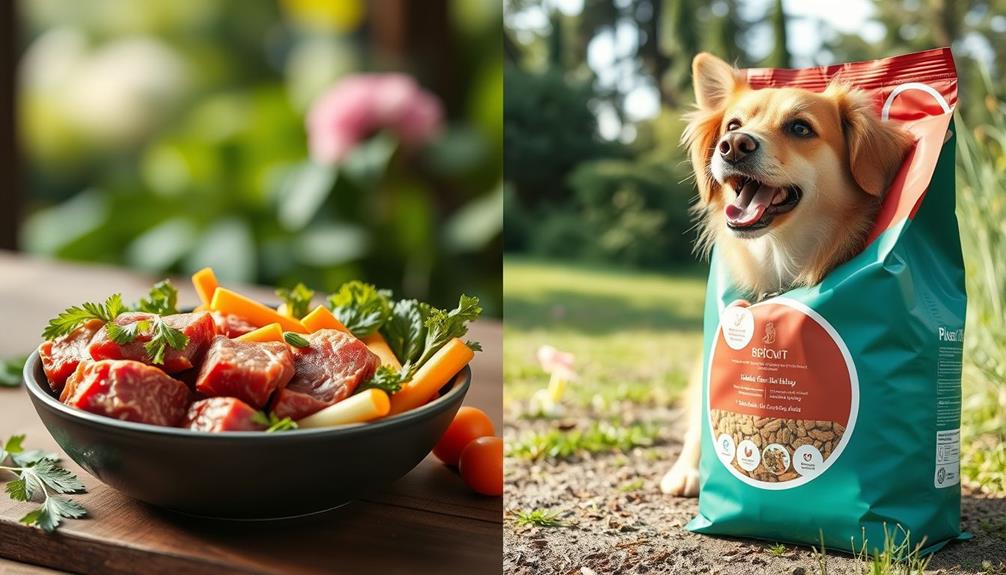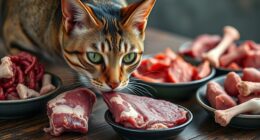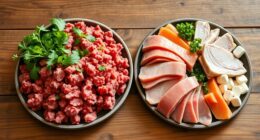To find the right amount of raw food for your dog, you should consider their weight, age, and activity level. Typically, adult dogs require 2-3% of their ideal body weight in raw food daily. For instance, a 30kg dog needs around 600g to 900g. Smaller breeds often need a higher percentage due to their faster metabolism. Make sure to monitor their weight regularly and adjust portions as needed, especially during extreme weather or changes in activity levels. There are calculators available to help you determine the specifics, and there's much more to discover about ideal feeding practices.
Key Takeaways
- Use a guideline of 2-3% of your dog's ideal body weight for adult dogs when calculating raw food amounts.
- Puppies require 5-10% of their body weight in raw food, adjusting as they grow.
- Monitor your dog's weight regularly to adjust food portions based on activity level and health needs.
- Nutritional ratios should consist of 70-80% muscle meat, 10% edible bone, and 5-7% organ meat for optimal health.
- Gradual transition to a raw diet over 7-10 days can help prevent digestive issues.
Factors Influencing Raw Food Amounts
When it comes to deciding how much raw food to feed your dog, several key factors come into play. You'll need to take into account your dog's activity level, age, breed, and metabolic rate, as these elements greatly influence their dietary needs.
For adult dogs, the general guideline is to feed them 2-3% of their ideal body weight in raw food daily. However, keep in mind that smaller breeds may require a higher percentage compared to larger breeds. It's also important to offer healthy dog snacks alongside their raw food to promote overall health and keep them engaged during mealtime.
Additionally, the temperature outside can impact your dog's food intake. For instance, during extreme weather, you might need to adjust their feeding amounts accordingly. Monitoring your dog's weight is essential; regular check-ins can help you determine if you need to make any adjustments.
Using a raw food calculator can simplify this process, helping you find the right amount tailored to your dog's specific needs. Remember, what works for one dog may not work for another. Once you have determined the appropriate amount of food for your dog, it’s important to follow raw food feeding instructions to ensure they are receiving a balanced diet. These instructions can provide guidance on portion sizes, protein sources, and the inclusion of essential nutrients. Following these guidelines will help keep your dog healthy and happy.
Adult Dog Feeding Guidelines
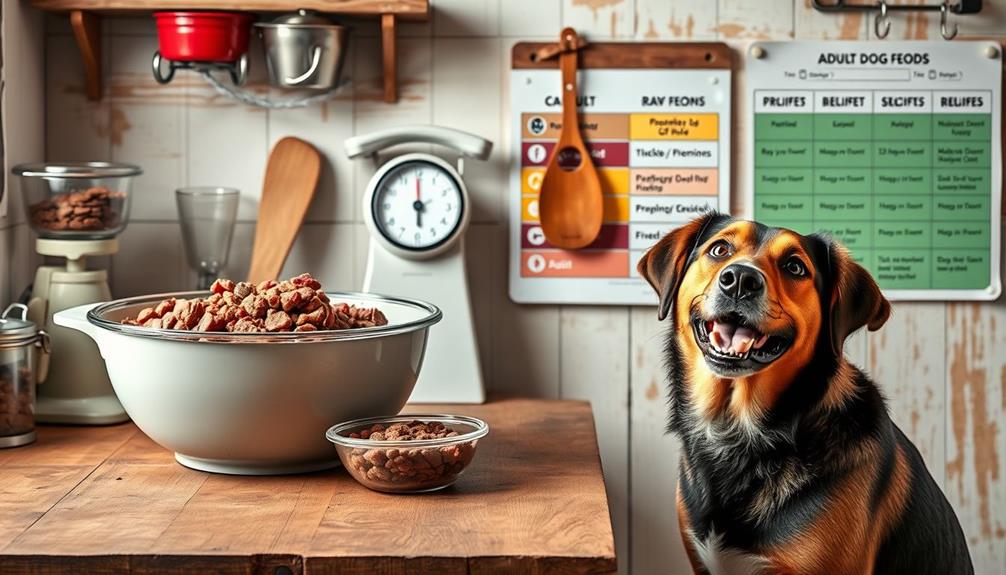
When feeding your adult dog, aim for 2% to 3% of their body weight in raw food daily. This guarantees they receive adequate nutrition for their overall well-being.
Keep in mind that factors like breed size, age, and activity level can affect how much food your dog needs. Regularly monitor their weight to adjust portions as necessary for peak health.
Consider the importance of selecting the right food types for specific dietary needs, as discussed in cold medications overview.
Daily Food Percentage
Feeding your adult dog the right amount of raw food is essential for their health and well-being. You should aim to provide 2% to 3% of their ideal body weight in raw food daily. For instance, if your adult dog weighs 30kg, their daily portion should range between 600g and 900g.
Keep in mind that smaller dogs may require a higher percentage of their body weight compared to larger dogs due to their faster metabolism. Additionally, it's important to take into account your dog's overall health and any specific dietary needs they may have, such as those related to age or medical conditions; consulting with a veterinarian can provide you with valuable guidance on nutritional needs.
To help you get started, reflect on these points:
- Split the total amount of raw food into two meals per day for the best digestion.
- Monitor your dog's weight regularly to verify they're getting the right amount of food.
- Adjust the daily portion based on factors like activity level and age, as these can affect nutritional needs.
Portion Adjustment Factors
Adjusting your dog's food portions is crucial for meeting their specific needs. Adult dogs typically require 2% to 3% of their body weight in raw food daily. For example, if your dog weighs 30kg, you should aim for approximately 600g to 900g of food each day.
Start by feeding them 2% to 2.5% of their body weight, then adjust based on their weight monitoring and individual health needs. It's important to take into account their overall health and lifestyle, as lifestyle for longevity can greatly impact their dietary needs.
Smaller dog breeds often need a higher percentage of their body weight in food compared to larger breeds, so tailor their meals accordingly. To promote digestion and maintain energy levels, it's best to split the daily amount into two meals—one in the morning and one in the evening.
Regularly assess your dog's dietary needs and weight to prevent obesity or underfeeding. Keep an eye on their body condition; if they're gaining or losing weight, be prepared to adjust the food amount.
Puppy Feeding Requirements

Understanding puppy feeding requirements is vital for guaranteeing your furry friend grows up healthy and strong. The amount of food needed varies considerably with your puppy's age, and providing a balanced diet is essential for their overall health and development.
Here's a quick guide to help you:
- 0-3 weeks: Only feed mother's milk.
- 3-4 weeks: Increase to 8% of your puppy's body weight daily.
- 12 weeks and older: Shift to two to three meals daily, reducing food to 5-6% of body weight by six months.
As your puppy grows, it's important to monitor their weight and adjust their food accordingly. This close observation will help you determine the right amount of food needed for ideal health and development.
It's important to remember that a proper diet, including fresh and nutritious options, can greatly impact your puppy's growth and energy levels, as well as their overall well-being, so consider exploring proper diet options for your puppy.
Using the Raw Food Calculator
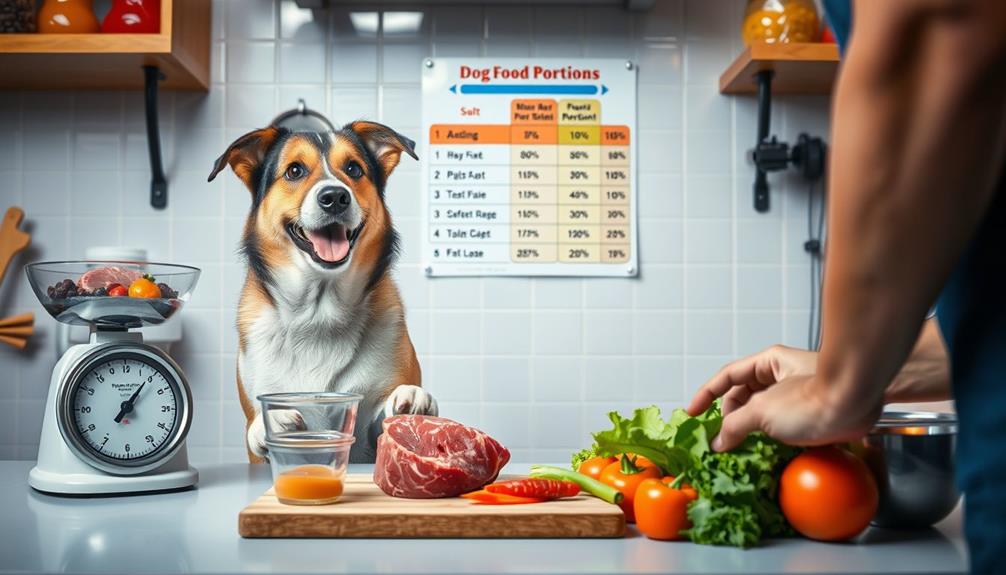
Using a Raw Food Calculator can greatly simplify the process of determining the right diet for your dog. By inputting your dog's weight, the calculator tailors dietary recommendations specific to their needs. For adult dogs, you'll typically feed 2-3% of their ideal body weight daily. Puppies, on the other hand, require 5-10% based on their growth stage.
Here's a quick reference table to help you understand feeding percentages:
| Dog Type | Percentage of Ideal Body Weight |
|---|---|
| Adult Dogs | 2-3% |
| Puppies | 5-10% |
| Raw Food % | 10% – 100% |
The raw dog food calculator also allows you to choose how much of their total diet should consist of raw food. It guarantees you get the right amounts of muscle meat, edible bone, and organ meats tailored for your dog. Remember, regular adjustments might be necessary based on your dog's response to raw feeding, activity level, and overall health. This tool can be invaluable in achieving a balanced diet that meets your dog's nutritional needs.
Weight Management Strategies
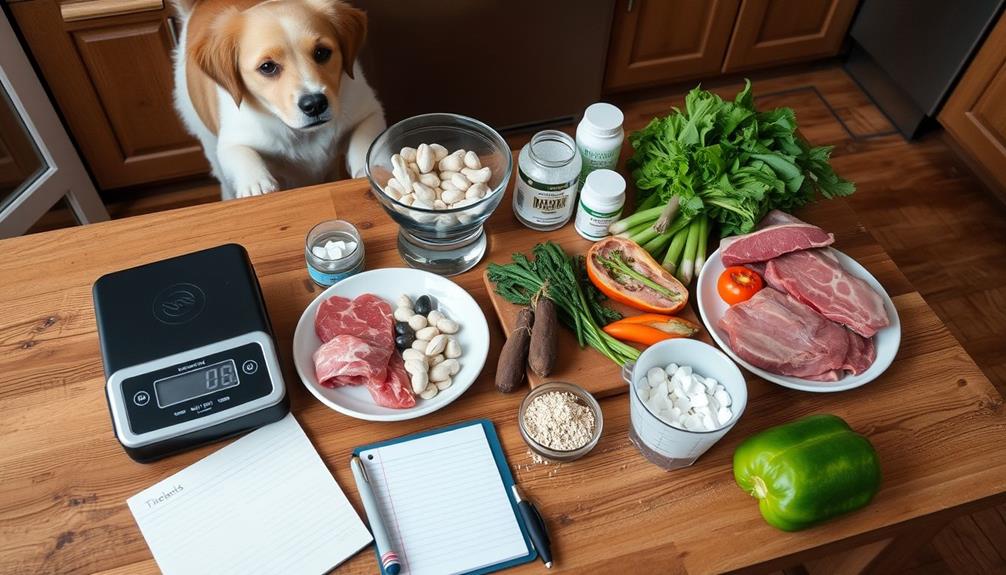
Maintaining a healthy weight for your dog is essential, especially when altering to a raw food diet. Regularly monitoring your dog's weight helps you adjust food portions based on their individual needs and metabolism.
Aim for a weight loss of 1-2% of your dog's body weight per week during this change. Understanding your dog's nutritional requirements can also help in making informed decisions about their diet and lifestyle, which is critical for long-term health and well-being.
Consider consulting with a veterinarian or a pet nutrition expert for personalized advice on financial mistakes to avoid that could impact your pet care budget.
Here are some effective weight management strategies:
- Use a raw food calculator to determine appropriate feeding amounts tailored to your dog's ideal body weight.
- Adjust food intake based on your dog's activity levels, age, and overall health to guarantee they're getting the right nutrients.
- For overweight dogs, consider reducing their food intake, while underweight dogs may need more to reach their ideal weight.
Nutritional Breakdown for Dogs

When switching to a raw food diet, it's important to guarantee your dog's nutritional needs are met. For adult dogs, aim for a breakdown of 70-80% muscle meat, 10% edible bone, and 5-7% liver and other organs. This combination ensures your dog receives the vital nutrients required for optimal health.
Understanding the key domains of development can also help in recognizing how dietary changes might impact your dog's overall well-being. If you have a puppy, adjust the ratios slightly: 58-69% muscle meat, 17% edible bone, and 7% liver and organs.
Adding vegetables can enhance their diet, making up about 7% of total food per day. This provides added fiber and nutrients for digestive health.
While seeds, nuts, and fruits can be beneficial, keep their inclusion minimal—just 1-3% of the overall diet will suffice.
Regularly evaluating the nutritional breakdown is vital to maintain a balanced diet tailored to your dog's specific health and activity needs.
Breed-Specific Feeding Recommendations

Feeding your dog according to their breed is vital for their overall health and well-being. Different breeds have unique dietary needs, and understanding these can help you maintain their ideal weight. For instance, smaller breeds like the Affenhuahua only require about 40g – 100g of food daily, while larger breeds, such as the Alaskan Malamute, may need between 680g – 900g. This variation underscores the significance of breed-specific feeding recommendations.
Additionally, just as toddlers benefit from best educational construction toys for toddlers that cater to their developmental needs, dogs too thrive when their dietary requirements are met based on breed.
Here are some key considerations for feeding your dog:
- Size Matters: Smaller breeds often need less food than larger ones.
- Nutritional Needs: Larger breeds, like the American Bulldog, may require up to 1080g daily to meet their higher energy demands.
- Cost Implications: Daily feeding costs can vary notably based on breed size, affecting your budget.
Regularly evaluating your dog's breed-specific dietary needs is essential. It guarantees they receive the right amount of food to support their health and maintain a healthy weight.
Monitoring and Adjusting Portions
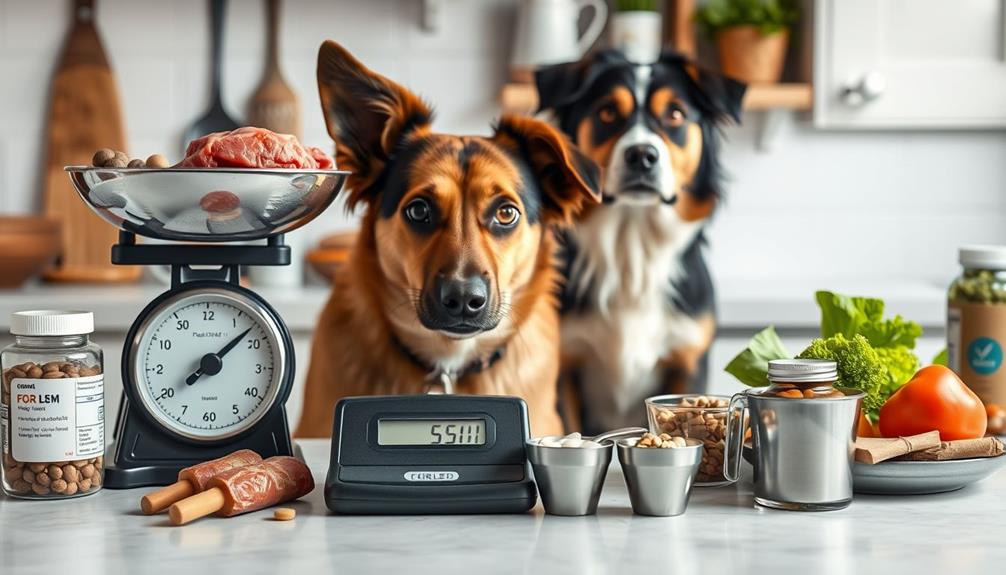
Understanding your dog's breed-specific dietary needs sets the foundation for their health, but it's just as important to monitor and adjust their food portions over time. Regularly checking your dog's weight helps guarantee they're getting the right amount of raw food, as their needs can change based on activity level, age, and metabolism.
To effectively manage your dog's diet, here's a simple guide to help you adjust portions:
| Dog Age | Percentage of Ideal Body Weight | Monitoring Frequency |
|---|---|---|
| Adult | 2-3% | Every 2-4 weeks |
| Puppy (up to 6 months) | 5% | Weekly |
| Weight Loss | Limit to 1-2% per week | Weekly |
| Active Dog | Increase as needed | Monthly |
| Senior Dog | Decrease if gaining weight | Bi-weekly |
Adjust food portions based on your dog's response to their diet. Consult with a veterinarian for tailored advice to guarantee your dog's nutritional needs are met effectively, making adjustments as necessary for their health and well-being.
Benefits of Raw Food Diet

Embracing a raw food diet for your dog can release a range of health benefits that enhance their overall well-being. Many dog owners report significant improvements, including better stool quality and effective weight management.
A raw food diet can support your dog's metabolism, leading to firmer stools that indicate enhanced digestion and nutrient absorption. Additionally, incorporating fresh ingredients can provide antioxidants that help combat oxidative stress and promote overall health, similar to the benefits noted in Cranberry Juice Consumption.
By providing the right nutrition, you help your dog maintain an ideal body weight and prevent obesity. Regular adjustments based on their body composition can further boost their health and vigor.
Here are some key benefits of a raw food diet:
- Shinier coats: Nutrient-rich raw food can lead to healthier skin and a glossy coat.
- Increased energy levels: A balanced diet supports an active lifestyle, ensuring your dog has the energy to play and explore.
- Improved overall well-being: With proper nutrition, your dog can experience better health and longevity.
Transitioning to a raw food diet might require some patience, but the benefits of a raw food diet are worth the effort. Your dog will thank you with wagging tails and playful antics!
Resources for Raw Feeding
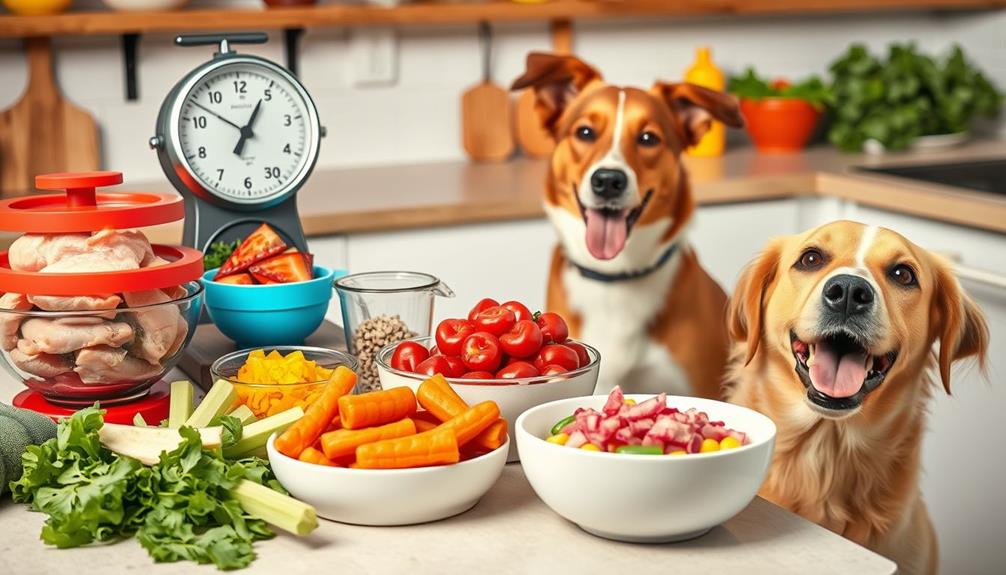
When you're considering a raw food diet for your dog, it's vital to understand essential feeding guidelines to guarantee proper nutrition.
Shifting your pup to raw can be tricky, but with the right resources, you can make the switch smoother. For instance, incorporating certain essential oils, such as eucalyptus oil for respiratory health, can support your dog's overall well-being.
Additionally, knowing about nutritional supplements can help you fill any gaps in their diet.
Essential Feeding Guidelines
Establishing your dog's feeding regimen is crucial for their health and well-being, especially when shifting to a raw food diet. Understanding how much raw food to feed your dog depends on various factors like age, size, and activity levels.
Adult dogs typically require 2-3% of their ideal body weight in daily food, while puppies need 5-10% for their rapid growth.
To tailor your dog's diet effectively, consider these essential guidelines:
- Monitor weight regularly: Adjust portions based on your dog's weight and overall health.
- Use a raw food calculator: It can help you determine personalized feeding amounts based on your dog's specific needs.
- Adjust for activity levels: More active dogs may require slightly more food to maintain their energy levels.
Keep in mind that shifting from dry to raw food may need careful adjustments to guarantee your dog adapts well.
Transitioning to Raw Diet
Shifting to a raw diet can often be a rewarding experience for both you and your dog, but it requires careful planning and resources to guarantee a smooth change. When moving to a raw diet, start by gradually introducing raw food over 7 to 10 days.
Mix a small percentage of raw food with your dog's current diet, slowly increasing the raw portion. This gradual approach allows your dog to adjust to the new food types without overwhelming their digestive system.
As you make this switch, monitoring your dog's response is essential. Keep an eye out for any digestive issues like diarrhea or vomiting. If you notice any adverse reactions, adjust the food portions accordingly to make sure your dog feels comfortable with their new meals.
Additionally, consider utilizing resources such as the "Beginners Guide To Raw Feeding" and "How To Switch To Raw Food" for valuable insights.
It's also wise to consult with an integrative veterinarian during this shift. They can provide tailored advice and support, guaranteeing your dog's nutritional needs are met effectively while making the switch to a raw diet.
Nutritional Supplements Overview
Many dog owners find that adding nutritional supplements can greatly enhance the benefits of a raw diet. These supplements provide essential vitamins and minerals that may not be sufficiently available in the raw food alone.
Before introducing any supplements, it's vital to consult with your veterinarian to guarantee they meet your dog's specific health needs.
Here are some common nutritional supplements you might consider:
- Fish oil: Rich in omega-3 fatty acids, it supports skin and coat health.
- Probiotics: These promote digestive health and can help with any tummy troubles.
- Calcium supplements: Often derived from eggshells, they strengthen bones and teeth.
In addition to these supplements, consider incorporating whole foods like fruits and vegetables into your dog's raw diet. They can provide extra fiber and nutrients, enhancing overall health.
Regularly assess your dog's health and dietary needs to determine if supplementation is necessary and make adjustments as needed. With the right nutritional supplements, you can guarantee your dog thrives on a raw diet.
Frequently Asked Questions
How Much Raw Food Should I Feed My Dog Chart?
To determine how much raw food you should feed your dog, consider their weight, age, and activity level. Generally, adults need 2-3% of their body weight, while puppies require 5-10%. Adjust as needed.
What Is the 80 10 10 Rule for Raw Dog Food?
Imagine a well-balanced feast for your furry friend. The 80/10/10 rule means you'll provide 80% muscle meat, 10% edible bone, and 10% organ meat, ensuring they get all the essential nutrients for vibrant health.
How Do I Calculate How Much Food to Feed My Dog?
To calculate how much food to feed your dog, consider their ideal weight and feed 2% to 3% daily. Adjust portions based on activity level, age, and monitor their health and stool quality regularly.
What Are the Proportions for Raw Dog Food?
Imagine crafting a perfect meal for your furry friend. For adult dogs, aim for 70-80% muscle meat, 10% edible bone, and 5-7% organs. Puppies need slightly different proportions to support their growth.
Conclusion
In the journey of feeding your dog a raw food diet, remember that every pup is unique, just like a fingerprint. By considering factors like age, weight, and activity level, you can tailor their meals to meet their specific needs. Keep an eye on their health and adjust portions as necessary. With time and attention, you'll not only nourish their body but also strengthen the bond you share. After all, a happy dog is a healthy dog!

